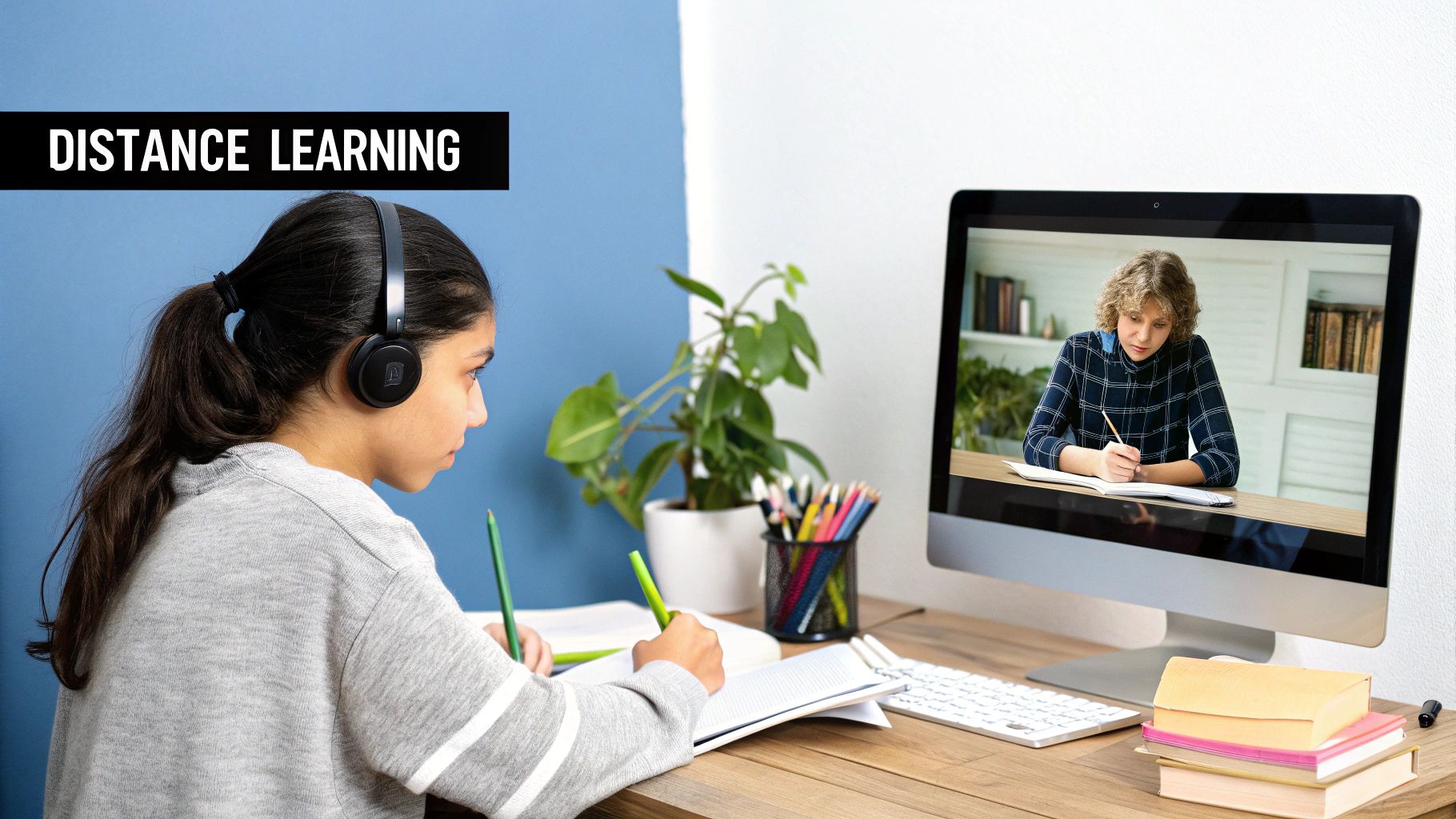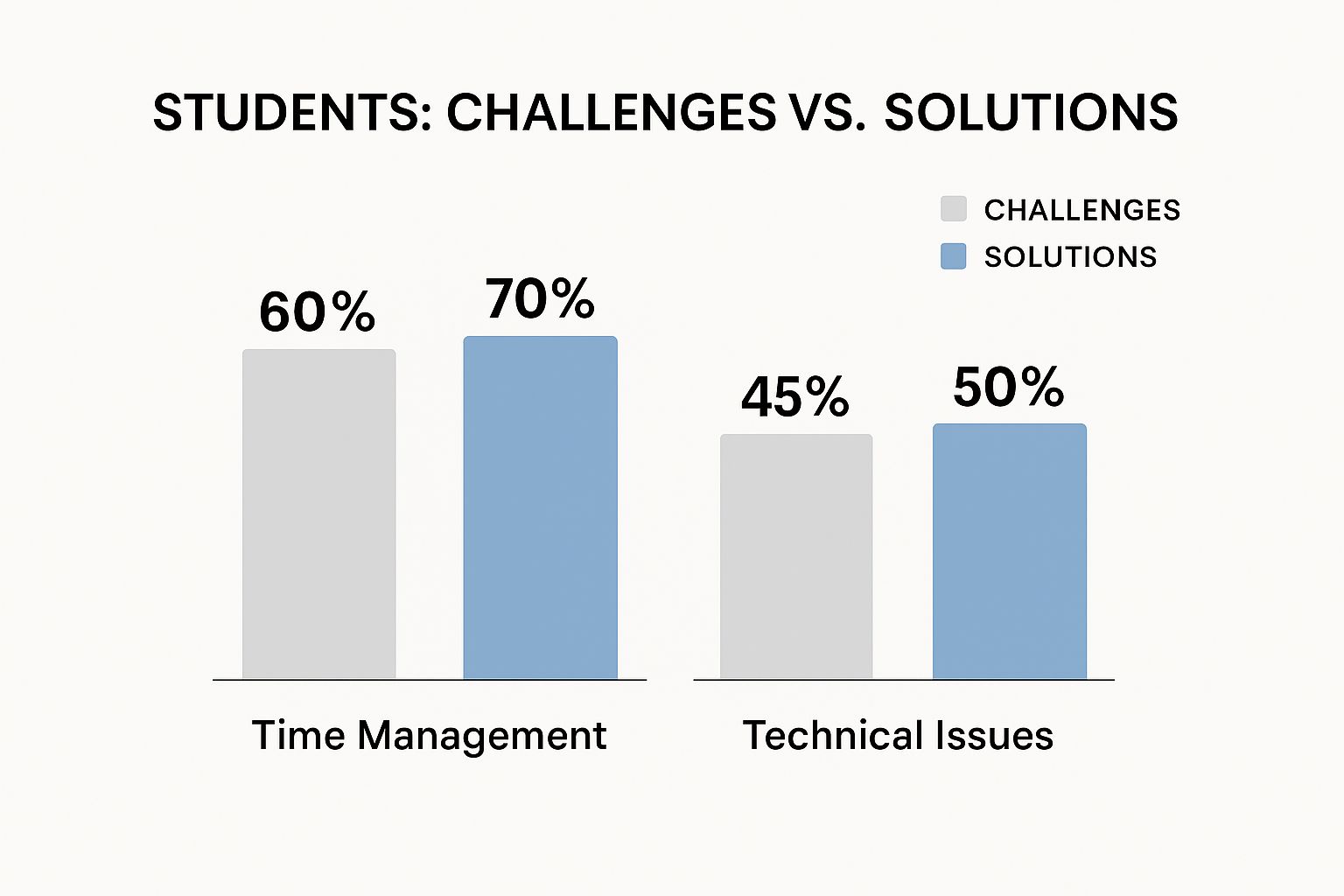Is the traditional school environment leaving your child feeling unseen, unheard, or simply uninspired? For many families, the answer is a resounding ‘yes’. A-Level distance learning offers a powerful alternative, shifting the focus from rigid schedules and classroom pressures to your child’s unique needs and passions.
This isn’t just about studying from home; it’s about crafting a personalised educational journey that can completely reignite their love for learning. Imagine the relief of knowing your child is in an environment designed for them to flourish, not just fit in.
What A-Level Distance Learning Actually Feels Like
If you’re picturing your child sitting alone with a dusty textbook, feeling isolated and unmotivated, it’s time to update that image. Modern A-Level distance learning is a dynamic, interactive, and surprisingly social experience. It’s about empowering your child, not isolating them. Imagine them waking up not with a sense of dread for the school day ahead, but with a feeling of calm control over their own learning.

A typical day isn’t about passively watching pre-recorded videos on loop. Instead, your child might log into a vibrant virtual learning environment where their History lesson is a live, real-time tutorial. They can ask their teacher questions directly without the fear of speaking up in front of 30 others, join debates with classmates in a chatbox, and even collaborate on projects in digital breakout rooms, feeling part of a team.
A Day in the Life of a Distance Learner
The real beauty of this model is how a day can be shaped around your child’s energy and learning style, not the other way around. This puts their needs first.
- For the morning person: They might decide to tackle their most challenging subject, like Chemistry, first thing. They can watch an animated video explaining a complex reaction, pausing and rewinding it as many times as they need without the pressure of a classroom bell or feeling like they’re holding others back.
- For the reflective learner: After a live tutorial, they can take the quiet time they need to truly absorb the information. Perhaps they’ll create a detailed mind map for an English Literature essay, completely free from the usual classroom distractions that can cause so much anxiety.
- For the visual, hands-on student: Instead of just reading about a dissection, they might engage with an interactive simulation for their Biology A-Level, exploring a virtual frog in detail at their own pace.
This flexibility puts your child’s well-being front and centre. If they have a medical appointment or are simply having a low-energy day, the schedule can adapt. Because lessons are recorded, nothing is ever truly missed. This alone removes a huge layer of anxiety that so often comes with traditional schooling.
A Structure Built for Success
Don’t mistake flexibility for a lack of structure. This model is a carefully designed academic path. In the UK, A-Level distance learning courses are typically structured over a two-year period, mirroring the timeline of a physical sixth-form college.
Students receive comprehensive online materials and dedicated tutor support, working through both the AS and full A-Level components. When it’s time for exams, they sit them as private candidates at registered centres. The qualifications they earn from awarding bodies like AQA or Edexcel are identical to those from any traditional school, ensuring their hard work is fully recognised by universities. To get a better feel for how these programmes are put together, you can explore detailed insights on A-Level courses.
The true power of this model lies in seeing your child take ownership of their education. It’s the moment they proudly explain a difficult concept they mastered on their own or share a fascinating point a peer made in a virtual debate.
This is about so much more than just achieving grades; it’s about nurturing a confident, self-directed young adult. For a child who felt lost in the crowd, the ability to learn at their own pace can be the key that unlocks their true potential and fosters a genuine, lasting passion for their subjects. It’s the difference between just surviving school and truly thriving in their education.
The True Benefits of Studying A Levels at Home
While the flexibility of A-Level distance learning is often the first thing that attracts families, the most profound benefits run much deeper. They are about nurturing your child’s well-being and fostering the kind of personal growth that genuinely prepares them for university and life beyond.
It’s about watching them transform from an anxious student into an independent, resilient, and self-assured young adult.

Many students find the constant background noise and social pressures of a traditional school exhausting. A home learning environment removes these distractions, creating a calm, focused space where a child’s confidence can finally blossom. Free from the fear of judgment, they feel empowered to ask questions and explore topics that genuinely spark their curiosity.
This isn’t about isolation; it’s about intentional focus. When your child can fully immerse themselves in their passion for Psychology or Maths without interruption, their understanding deepens and their enthusiasm for learning grows.
Developing Skills for Life, Not Just for Exams
The very structure of A-Level distance learning cultivates skills that are highly sought after by top universities and future employers. This is where your child doesn’t just learn subjects; they learn how to learn.
Imagine a student—let’s call her Chloe—who always found school deadlines terrifying, leading to late nights and immense stress. With A-Level distance learning, she has to plan her own weekly schedule. It’s challenging at first, but with guidance from her tutor, she learns to block out her time, prioritising her more difficult subjects and scheduling restorative breaks.
Within a few months, Chloe isn’t just submitting work on time; she is managing her entire academic workload independently and with less anxiety. This self-discipline and exceptional time management are skills she will carry with her into university and her future career. She has learned a life lesson in responsibility that a rigid school timetable could never teach.
This shift from being a passive recipient of information to an active architect of one’s own education is where the real magic happens. It’s about building the resilience to overcome challenges and the self-discipline to stay on track, even when motivation wavers.
A Focus on Mental Wellbeing and Personal Pace
One of the most significant advantages is the ability to create a learning schedule that respects your child’s natural rhythm and energy levels. The pressure of a one-size-fits-all system is lifted, replaced by a supportive framework that puts their well-being first.
This move towards self-directed, technology-supported education is becoming more common across the UK. The adoption of digital learning tools has surged, with over 60% of students now using them. A staggering 90% of learners appreciate the flexibility this offers. Meanwhile, homeschooling numbers, which often rely on distance learning, rose to 126,000 in England during the 2022-23 academic year, showing a strong parental desire for more personalised educational paths.
The emotional benefits of this model are substantial. For a student who has experienced bullying or social anxiety, a home environment provides a safe haven where they can focus on their studies without fear. You can learn more about the positive impact of this model by reading our guide on the wider benefits of virtual learning.
Ultimately, studying A-Levels from home is not just an alternative way to pass exams. It is an opportunity to nurture an independent thinker, a confident problem-solver, and a well-rounded young adult who is genuinely prepared for the challenges and opportunities that lie ahead.
How to Choose the Right Online A Level Provider
Picking the right provider for your child’s A-Level distance learning is probably the most important decision you’ll make in this whole process. It’s a choice that goes way beyond just flicking through a course catalogue or comparing prices. You’re choosing a partner in your child’s education—a team that will support them both academically and emotionally through two of their most formative school years.
The gap between a basic content-dump platform and a truly supportive online college is huge. One just gives you the materials; the other provides a community, expert guidance, and a real framework for your child’s success. To see past the slick marketing, you need to ask the right questions and focus on what will genuinely shape your child’s daily experience and future options.
Ultimately, this is about putting your child’s unique needs front and centre. You want to ensure they don’t just walk away with a qualification, but that they also have a positive, enriching, and confidence-building experience along the way.
Look Beyond the Course List
Sure, every provider will offer the core A-Level subjects, but the quality of how those subjects are delivered can vary enormously. Your first job is to dig into the specifics of how the teaching and support actually function day-to-day. This isn’t just about what they teach, but how they teach—and, crucially, what happens when your child gets stuck.
Think about your child. Do they come alive with live interaction, or are they a self-starter who prefers to work independently? Do they need a friendly face to check in on them, or are they happy to reach out when they need help?
- Tutor Qualifications and Availability: Be direct with your questions. Are the tutors qualified teachers with real experience in the UK curriculum? What are their specific office hours for one-to-one help? A provider offering scheduled, live tutorials and prompt marking with detailed, constructive feedback is in a different league from one where “support” means a generic email reply two days later.
- Pastoral Care and Wellbeing: What happens if your child feels overwhelmed or starts to fall behind? This is a crucial question. A great provider has dedicated pastoral staff, just like a good physical school, who actively check in with students. This emotional safety net can be the single biggest factor in your child’s success and happiness.
- The Virtual Learning Environment (VLE): Is the platform actually intuitive and easy for your child to use? Always ask for a trial login or a live demonstration. A clunky, badly designed system can quickly become a source of daily frustration and a genuine barrier to learning.
It’s clear that finding the right fit requires some careful thought. For a more detailed, step-by-step guide, you can explore our comprehensive article on how to choose an online school that aligns perfectly with what your child needs.
The goal is to find a provider that sees your child as an individual, not just another enrolment number. A good online college understands that its responsibility extends far beyond academics to include student well-being and personal growth.
The infographic below shows some common hurdles students face in online learning. More importantly, it shows how effective strategies—often taught and reinforced by a quality provider—can make all the difference.

The data here is clear: while challenges do exist, the adoption of effective solutions massively outpaces the problems themselves. The right support makes students resilient.
Practical Support Makes All the Difference
One of the key things that separates an excellent provider from an average one is practical, real-world support. This is especially true when it comes to exams. After all, an A-Level is pretty useless without the final exam certificate, and the stress of arranging them can be immense.
Let’s look at a quick scenario, focusing on the child’s experience.
Imagine two students, both studying A-Level History online.
- Student A is with a basic provider. When exam time rolls around, they are just emailed a list of possible exam centres and told to sort it out themselves. The process is confusing, the best centres are already full, and the stress eats into valuable revision time, causing sleepless nights and anxiety for the whole family.
- Student B is with a supportive online college. The college has established partnerships with exam centres across the country. A dedicated coordinator walks the family through the entire registration process, taking care of the logistics and making sure all deadlines are met without any of the drama. The child can simply focus on their studies, feeling secure and supported.
The difference in experience is profound. A provider that helps you navigate the often-tricky logistics of being a private candidate shows a true commitment to its students’ success from beginning to end. This practical help frees up your child to focus on what actually matters: mastering the material and acing those exams.
Choosing wisely means finding a partner who will be there for every single step of your child’s journey.
Of all the aspects of A-Level distance learning, the thought of organising the final exams can feel like the most daunting hurdle. For many parents, it’s a big unknown, stirring up worries about logistics, deadlines, and unexpected costs. It doesn’t have to be a source of stress.
With a clear, step-by-step approach, managing the exam process as a private candidate can be surprisingly straightforward. The goal here is to cut through the confusion and turn it into a simple, actionable plan. This frees up your child to focus on what really matters—mastering their subjects and walking into the exam hall with confidence.

Finding Your Local Exam Centre
Your first job is to find an approved school or college that accepts private candidates for the specific subjects and exam boards your child is studying (like AQA or Edexcel). It’s worth knowing that not all centres accommodate every A-Level, especially those with practical coursework, such as the sciences.
It’s always best to start this search early—ideally right at the beginning of the academic year. You can find lists of approved centres on the websites of the major exam boards. Many good online schools also have partnership centres, which can make this whole process much easier.
A Step-by-Step Guide to Exam Registration
Once you have a shortlist of potential centres, the process usually looks like this:
- Make Initial Contact: Get in touch with the exams officer at your chosen centres. Be clear that your child is an external or private candidate and list the exact subjects and exam boards they need.
- Gather Your Information: You’ll need your child’s Unique Candidate Identifier (UCI) number if they’ve sat UK public exams before. You will also need the specific specification codes for each of their subjects.
- Understand the Fees: The total cost will be a combination of the exam board’s own entry fees plus an administration fee from the centre to cover things like invigilation and room hire. Always ask for a full breakdown so there are no surprises down the line.
- Meet the Deadlines: Exam entry deadlines are non-negotiable and typically fall in February for the May/June exam series. Missing them can mean late fees or, even worse, not being able to sit the exam at all.
Sorting out these logistics is just a necessary part of the distance learning journey. Planning ahead removes that last-minute panic and helps ensure a smooth path to their qualification.
The feeling of relief once the exams are booked is immense. It transforms an abstract goal into a tangible reality, giving your child a clear target to work towards and boosting their motivation for that final stretch of revision.
Understanding the Study Commitment
While the practicalities are crucial, so is having a realistic grasp of the academic workload. A good online course is designed to build knowledge progressively, but it absolutely requires consistent, dedicated effort from your child.
For example, a student taking A-Level Biology will likely find the curriculum broken down into manageable weekly topics. One week might focus on cellular structures, complete with interactive diagrams and quizzes to check their understanding. The next might move on to genetics, supported by a live tutorial and collaborative problem-solving tasks that make the learning feel active and engaging.
This structured approach is vital, especially for subjects that demand a huge amount of self-study. For instance, A-Level Mathematics and Statistics courses often require around 700 hours of study over the two years. Distance learning providers use a mix of electronic media and online tech to deliver this content, allowing students to access materials whenever it suits them. This flexible but rigorous model maintains high academic standards while opening up A-Levels to a wider range of learners. You can discover more about how these flexible A-Level courses are structured.
By understanding both the practical steps for exams and the week-to-week study expectations, you and your child can tackle the final phase of their A-Level journey with confidence and a clear sense of purpose.
Creating a Nurturing Home Learning Environment
When your child starts their A-Level distance learning journey, your role as a parent undergoes a wonderful shift. You’re no longer the director of their education; you become their most trusted coach and number one supporter. The right home environment is the bedrock of this new chapter, and it’s built on far more than a tidy desk and a fast internet connection.
It’s about creating a space where your child feels safe, heard, and empowered to grow, both academically and emotionally. This is a brilliant opportunity to forge a partnership that champions their independence while providing a reliable safety net for the inevitable challenges that come with A-Level study.
Your goal isn’t to mimic a school classroom. It’s to build something much better: an environment fine-tuned to your child’s unique way of learning.
From Supervisor to Supportive Coach
It’s tempting to want to micromanage, especially when their education is happening under your roof. But the most successful home learning setups are built on trust and collaboration, not constant supervision. Your child is learning to become a self-reliant student, and your role is to guide them, not command them.
Think of it this way: instead of standing over their shoulder checking off every task, you’re sitting beside them at the start of the week, looking at their schedule together. You’re not the manager demanding progress reports; you’re the coach helping them map out a winning game plan.
This shift in dynamic is where the real growth happens. It’s the moment you stop asking, “Have you finished your work?” and start asking, “What was the most interesting thing you learned today?” This simple change transforms a stressful check-in into a moment of genuine connection and shared excitement.
Building a Routine That Nurtures Wellbeing
A healthy routine is the scaffolding that holds a successful learning experience together. It offers structure without being rigid, creating a healthy balance between focused study and the rest and connection that are so vital for your child’s wellbeing.
Sit down with your child and build a schedule that respects their natural energy levels and learning preferences.
- Designated Study Space: Carve out a specific, clutter-free area just for learning. It doesn’t need to be a separate room—a quiet corner of the living room can work perfectly—but it should be a clear signal to their brain that it’s time to focus.
- Collaborative Goal Setting: Plan out weekly goals together. This might be finishing all their Maths assignments by Thursday or completing a first draft of a History essay by Friday. This shared ownership gives them a powerful sense of control and reduces overwhelm.
- Balance is Everything: Make sure their day isn’t all about academics. Schedule in time for physical activity, socialising with friends (online or in person), creative hobbies, and—crucially—unstructured downtime to simply recharge.
This philosophy is central to effective online homeschooling, where academic achievement and mental health are treated with equal importance. It’s a recognition that a happy, well-rested child is a far more effective learner.
One family we know found their son, Ben, was really struggling with motivation in the afternoons. Instead of pushing him harder, they completely restructured his day based on his needs. Now, he tackles his most demanding subjects in the morning, takes a long break for lunch and a walk, and uses the afternoons for lighter revision or creative projects. His stress levels plummeted, and his grades shot up. That simple, empathetic adjustment made all the difference to his well-being and success.
By focusing on partnership and wellbeing, you create an environment where your child doesn’t just complete their A-Levels—they build the confidence, resilience, and self-discipline that will set them up for life.
Common Questions About A Level Distance Learning
Deciding to explore A Level distance learning is a big step, and it’s completely natural for parents and students alike to have questions. It’s all about finding the right path for your child, and you need clarity to make a confident choice. We want to tackle your most pressing concerns head-on, replacing any uncertainty with the clear, honest answers your family deserves.
It’s okay to feel a bit apprehensive. You’re looking at a different model from the one you know, and while it’s full of potential, it can feel unfamiliar. Let’s get straight to the most common questions to help you see the way forward for your child.
Are Online A Levels Recognised by Universities?
This is usually the first question parents ask, and the answer is a simple, resounding yes. A Levels earned through an accredited online school carry the exact same weight and value as those from a traditional sixth-form college. They are awarded by the same official bodies, like AQA, Pearson Edexcel, and OCR.
When it comes time to apply for university, your child’s UCAS application will show the same qualifications. Universities care about the grades achieved and the student’s personal statement, not the building where the learning happened.
In fact, the self-discipline and independence gained through A Level distance learning are often seen as a huge plus. It shows universities your child is ready for the kind of self-directed study expected in higher education, which can make their application stand out.
How Will My Child Make Friends and Socialise?
The fear of isolation is a major emotional hurdle for many families. It’s a valid worry, but it’s often based on an outdated picture of online learning. Any good online school puts a huge emphasis on building a vibrant and supportive community so that no child feels alone.
A thriving online school isn’t just a collection of courses; it’s a living community. It’s where students find their tribe, build lasting friendships, and learn that connection isn’t limited by geography.
Modern online schools create countless opportunities for students to connect:
- Live, Interactive Classes: These aren’t one-way lectures. Students get involved in debates, work together in digital breakout rooms, and talk with teachers and classmates in real-time, building a natural rapport.
- Student Common Rooms: Virtual spaces let students chat, share ideas, and just hang out—much like they would in a physical common room, but in a way that can feel less intimidating.
- Clubs and Societies: From book clubs and coding groups to debating societies, online schools offer a huge range of extracurricular activities that connect students with shared interests from all over the world.
Here’s a practical example: Imagine your daughter, who loves creative writing but was too shy to join the club at her old school. She joins her online school’s literary club. Here, she connects with peers from different countries, shares her stories in a supportive chat, gets helpful feedback, and even works on a student magazine. She isn’t just avoiding isolation; she’s building a global network of friends based on a real, shared passion, boosting her confidence immensely.
What if My Child Needs Extra Help?
This is where the quality of an online provider really shows. Think about a traditional classroom of 30 pupils, where a shy child might not feel comfortable raising their hand. Online learning can offer far more direct and accessible support, as the best providers build their entire model around personalised attention for each child.
Your child won’t be left to figure things out alone. Strong support systems often include:
- One-to-one tutor sessions that can be easily booked to go over tricky topics, giving your child the focused attention they need.
- Dedicated pastoral support from staff focused on student wellbeing, not just grades. This person is a trusted point of contact for when your child feels anxious or overwhelmed.
- Regular progress reviews to proactively check in and make sure your child is on track and feeling confident, catching any wobbles before they become major roadblocks.
The goal is to provide help the moment it’s needed, stopping small wobbles from turning into major learning roadblocks. This responsive, student-first approach ensures every child has the tools and confidence they need to succeed.
At Queens Online School, we understand that choosing the right educational path for your child is a profound decision. We combine a fully accredited British curriculum with live, interactive lessons and dedicated pastoral care to create an environment where every student can thrive. Discover how our supportive community can empower your child to achieve their full potential.

